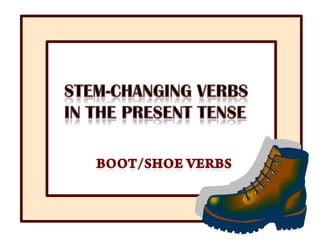Denunciar
Compartilhar

Mais conteúdo relacionado
Mais procurados
Mais procurados (20)
Semelhante a Stem changing Verbs
Semelhante a Stem changing Verbs (20)
The Present Tense Of Verbs With Spelling Changes & Irregular Verbs

The Present Tense Of Verbs With Spelling Changes & Irregular Verbs
t2-e-5356-simple-past-present-and-future-tense-powerpoint--_ver_9.pptx

t2-e-5356-simple-past-present-and-future-tense-powerpoint--_ver_9.pptx
Mais de Seema Sumod
Mais de Seema Sumod (20)
Último
Explore beautiful and ugly buildings. Mathematics helps us create beautiful d...

Explore beautiful and ugly buildings. Mathematics helps us create beautiful d...christianmathematics
Último (20)
9548086042 for call girls in Indira Nagar with room service

9548086042 for call girls in Indira Nagar with room service
Kisan Call Centre - To harness potential of ICT in Agriculture by answer farm...

Kisan Call Centre - To harness potential of ICT in Agriculture by answer farm...
Russian Escort Service in Delhi 11k Hotel Foreigner Russian Call Girls in Delhi

Russian Escort Service in Delhi 11k Hotel Foreigner Russian Call Girls in Delhi
Beyond the EU: DORA and NIS 2 Directive's Global Impact

Beyond the EU: DORA and NIS 2 Directive's Global Impact
Explore beautiful and ugly buildings. Mathematics helps us create beautiful d...

Explore beautiful and ugly buildings. Mathematics helps us create beautiful d...
Web & Social Media Analytics Previous Year Question Paper.pdf

Web & Social Media Analytics Previous Year Question Paper.pdf
Ecosystem Interactions Class Discussion Presentation in Blue Green Lined Styl...

Ecosystem Interactions Class Discussion Presentation in Blue Green Lined Styl...
BAG TECHNIQUE Bag technique-a tool making use of public health bag through wh...

BAG TECHNIQUE Bag technique-a tool making use of public health bag through wh...
Stem changing Verbs
- 4. In verbs that have an e to ie change, when you conjugate the verb, you change the ‘ e ’ in the stem to ‘ ie ’ in all forms except the nosotros form .
- 6. Examples of e ie Stem-Changing verbs in the present tense: tener– to have venir – to come
- 7. Tener (to have) and Venir (to come) are also e-ie stem-changing verbs but these verbs have an irregular ’yo’ form. TENER – to have Yo tengo Nosotros tenemos Tú tienes Él Ella tiene Usted Ellos Ellas tienen Ustedes VENIR – to come Yo vengo Nosotros venimos Tú vienes Él Ella viene Usted Ellos Ellas vienen Ustedes
- 11. In verbs that have an o to ue change, when you conjugate the verb, you change the ‘ o ’ in the stem to ‘ ue ’ in all forms except the nosotros form .
- 13. Examples of o ue Stem-Changing verbs in the present tense:
- 14. Jugar (to play a sport/game) is a u-ue stem-changing Jugar– to play (a sport/game) Yo juego Nosotros jugamos Tú juegas Él Ella juega Usted Ellos Ellas juegan Ustedes
- 18. In verbs that have an e to i change, when you conjugate the verb, you change the ‘ e ’ in the stem to ‘ i ’ in all forms except the nosotros form .
- 20. Examples of e ie Stem-Changing verbs in the present tense:
- 21. Seguir (to follow) and Conseguir (to get) are also e-i stem-changing verbs but these verbs have an irregular ’yo’ form. Seguir– to follow Yo sigo Nosotros seguimos Tú sigues Él Ella sigue Usted Ellos Ellas siguen Ustedes Conseguir– to get Yo consigo Nosotros conseguimos Tú consigues Él Ella consigue Usted Ellos Ellas consiguen Ustedes
